Sfogliatelle Ricce is an iconic Italian pastry originated in Naples, Campagnia region. Super thin layers of crunchy dough filled with delicious orange and cinnamon flavored ricotta cream.
In this recipe you'll find everything you need to make it a success: best tools to use, tips and tricks ans step by step pictures.
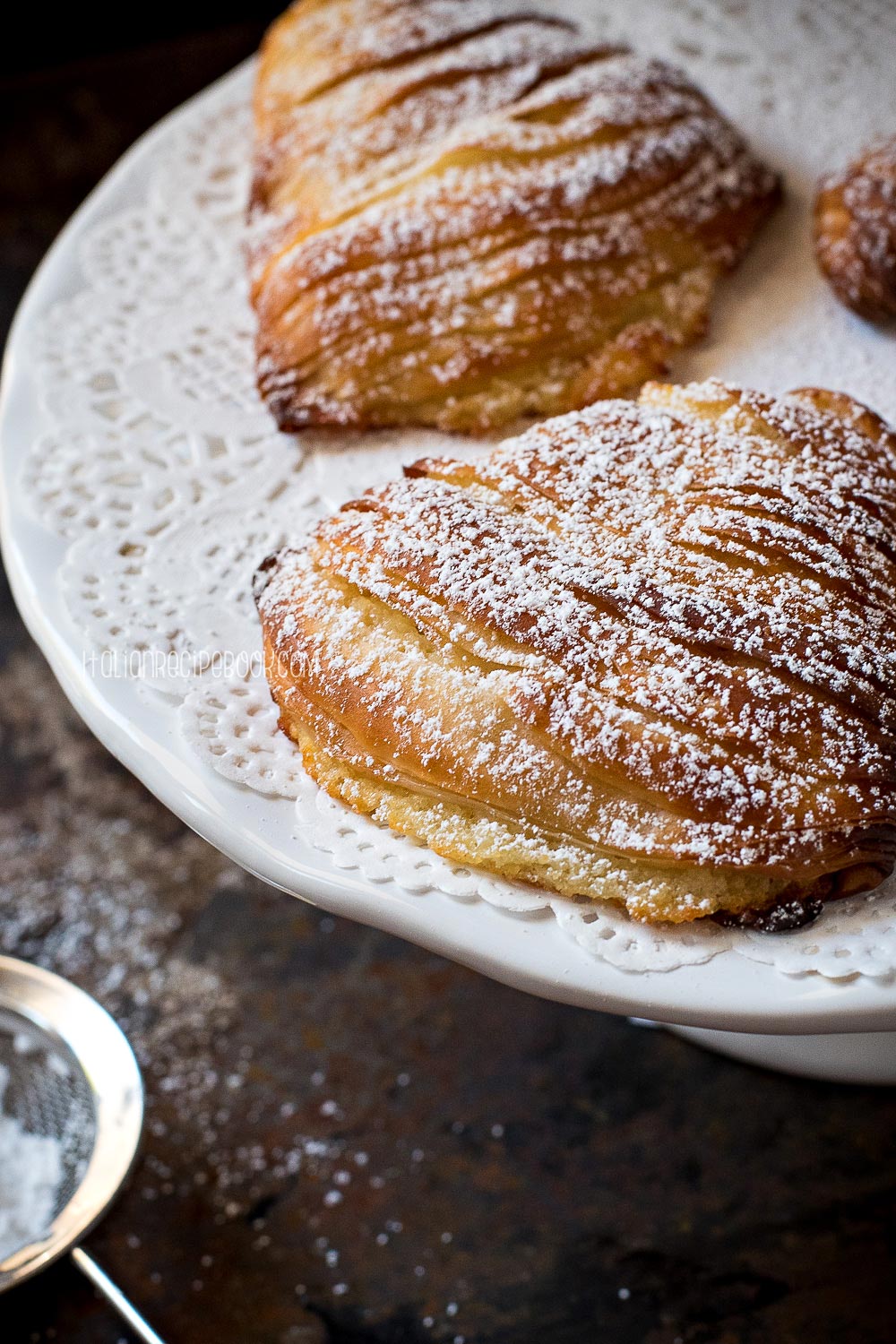
The word Sfogliatelle is pronounced as [sfoo-llia-te-lle] in its plural form. One single pastry is called "sfogliatella". In Neapolitan dialect you might often hear them pronounced as [schwee-ah-dell]. Whatever you call them, they are a dream, a magic and a legend in and of itself.
Some might say that they’re also known for being complicated to make and even complicated to explain the whole preparation process.
But let me assure you, with a little bit of patience, a good pasta machine and these step-by-step photo instructions you can easily and successfully learn how to make your own homemade sfogliatelle! Let's start with the tools you'll need.
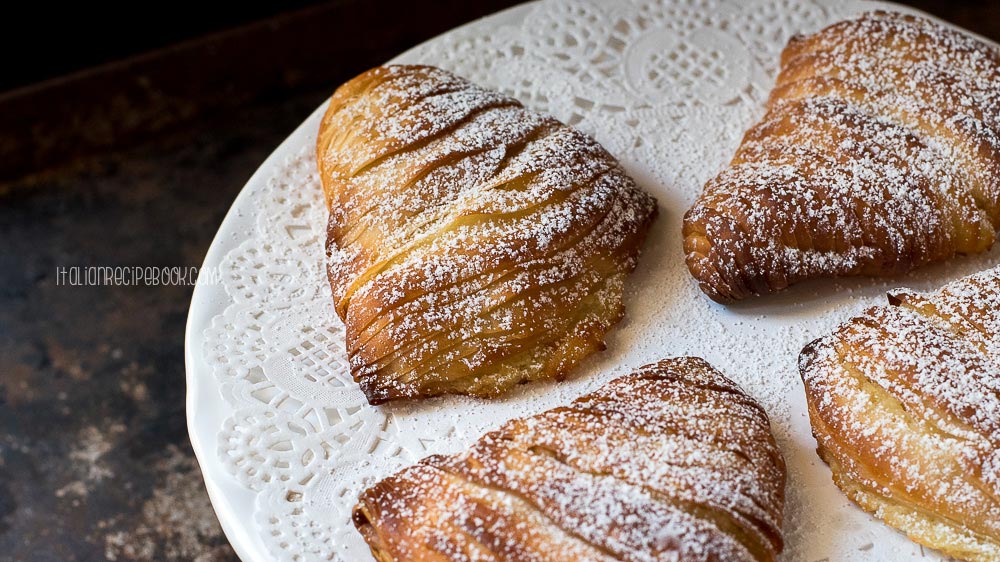
Table Of Contents
Ingredients
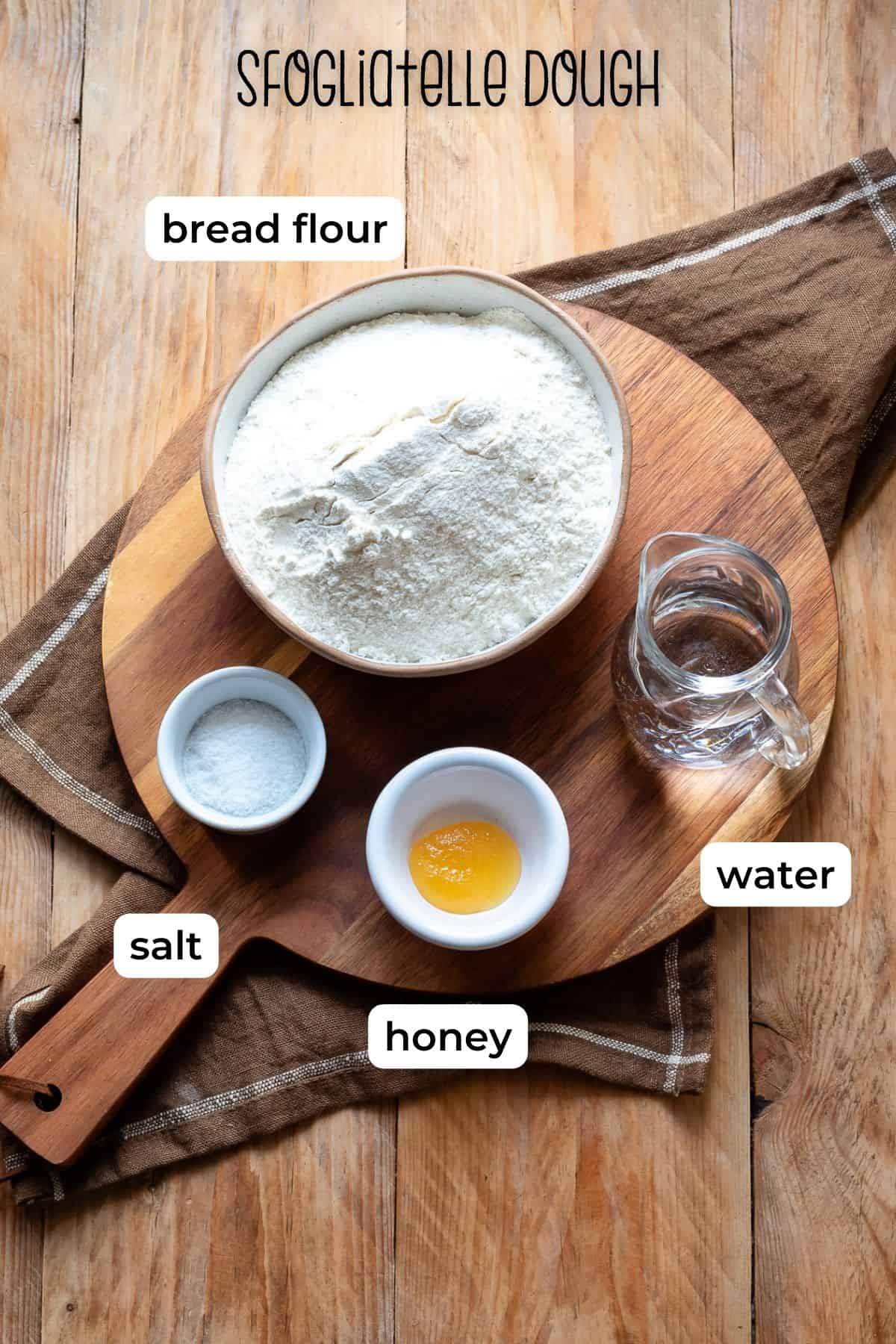
- For the dough:
- bread flour - high protein bread flour is key, otherwise you will not be able to stretch it paper thin!
- honey - acacia honey is the best, avoid any honey with bitter notes or strong flavor such as clover, eucalyptus etc.
- salt
- water
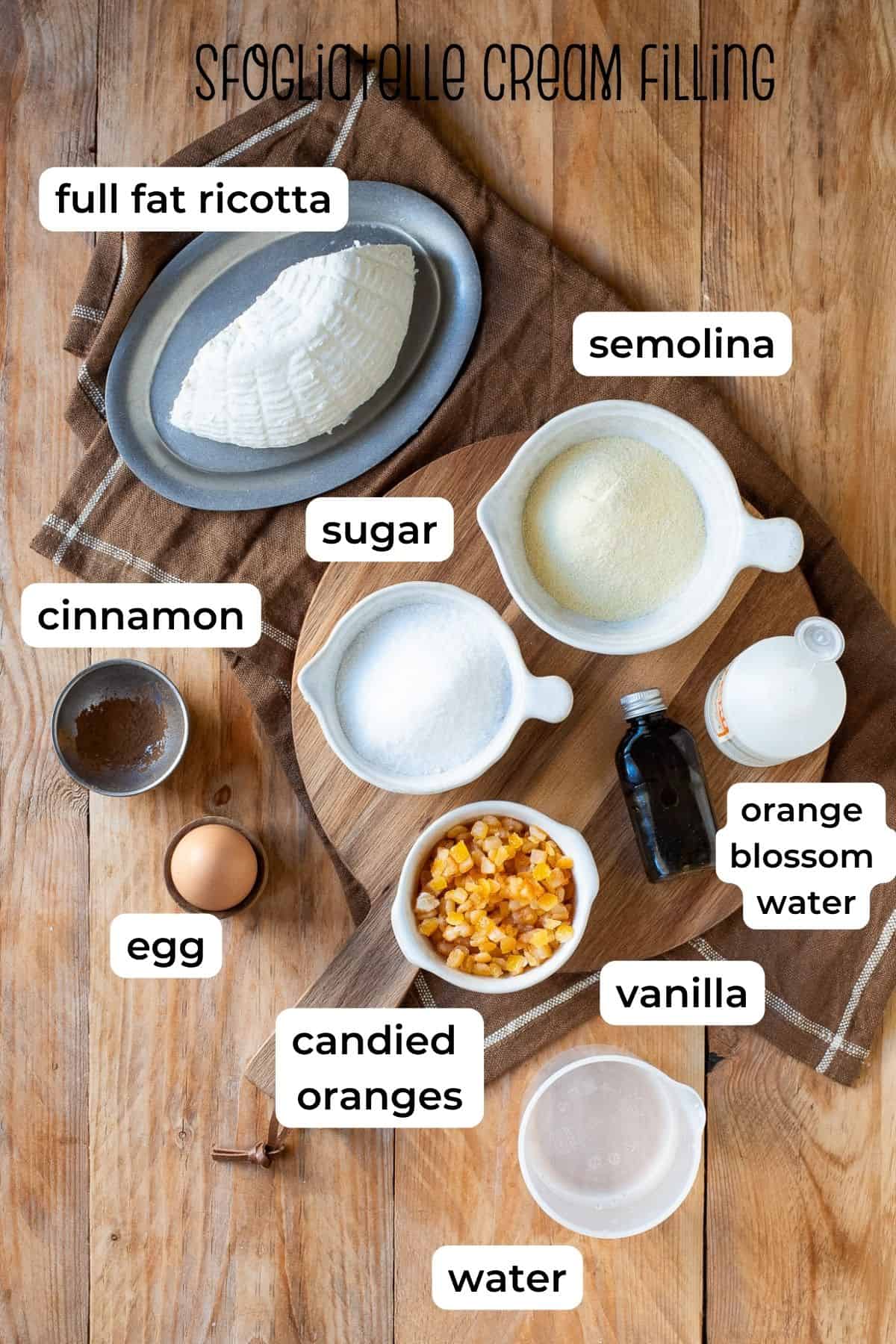
- For ricotta cream:
- full fat ricotta - for the perfect creaminess. If ricotta is lean, add a few tablespoons of butter.
- semolina flour - preferably coarse grind!
- sugar
- water - for cooking semolina, sometimes it's substituted with milk.
- egg - to bind the filling
- cinnamon, vanilla, candies orange peels, orange blossom water or extract (skip if you can't find it).
Essential Tools
- For the dough:
- Pasta Machine
- Rolling Pin or two so that you can distribute the dough onto 2 rolling pins and easing the unrolling (you'll see below in details).
- Large work surface, preferably wooden
- For ricotta cream filling:
- Small Pot
- Large mixing bowl
- Whisk
- Spatula
Wondering if you really need pasta machine to make sfogliatelle?
The short answer is YES! If you want to facilitate the process pasta machine is essential for super thin dough rolling. Not that you can’t do it by hand (you certainly can) but it requires certain skills. Besides pasta machine will save you a ton of energy and time and at the same time giving a better quality pastry.
I'm using Atlas Pasta Machine by Marcato. And not only for sfogliatelle but for ALL things pasta and pastries that require thin and equal rolling. You can read my review, detailed user guide and cleaning and care instructions here: Atlas Pasta Machine by Marcato (Detaild Review & User Guide).
Another essential tool to make sfogliatelle (even if you're going to use pasta machine) is a rolling pin. Better if you have two, I'll explain why.
Standing mixer is optional.
How To Make - Step By Step Pictures
Preparing the dough
- Dissolve honey and salt in water.
- In a large bowl, add flour and water mix saving a few tablespoons for later. Mix with a fork or a Danish dough whisk until crumbly. Separate dough lumps from the dry flour left at the bottom.
- Add remaining water to the dry flour and mix with your hands letting the dough absorb any remaining dry flour. The dough will be super lumpy and that's how it should be! It’ll all come together later in the process.
- Cover the dough and let sit for 30 minutes.
Using a stand mixer? Follow the same process.
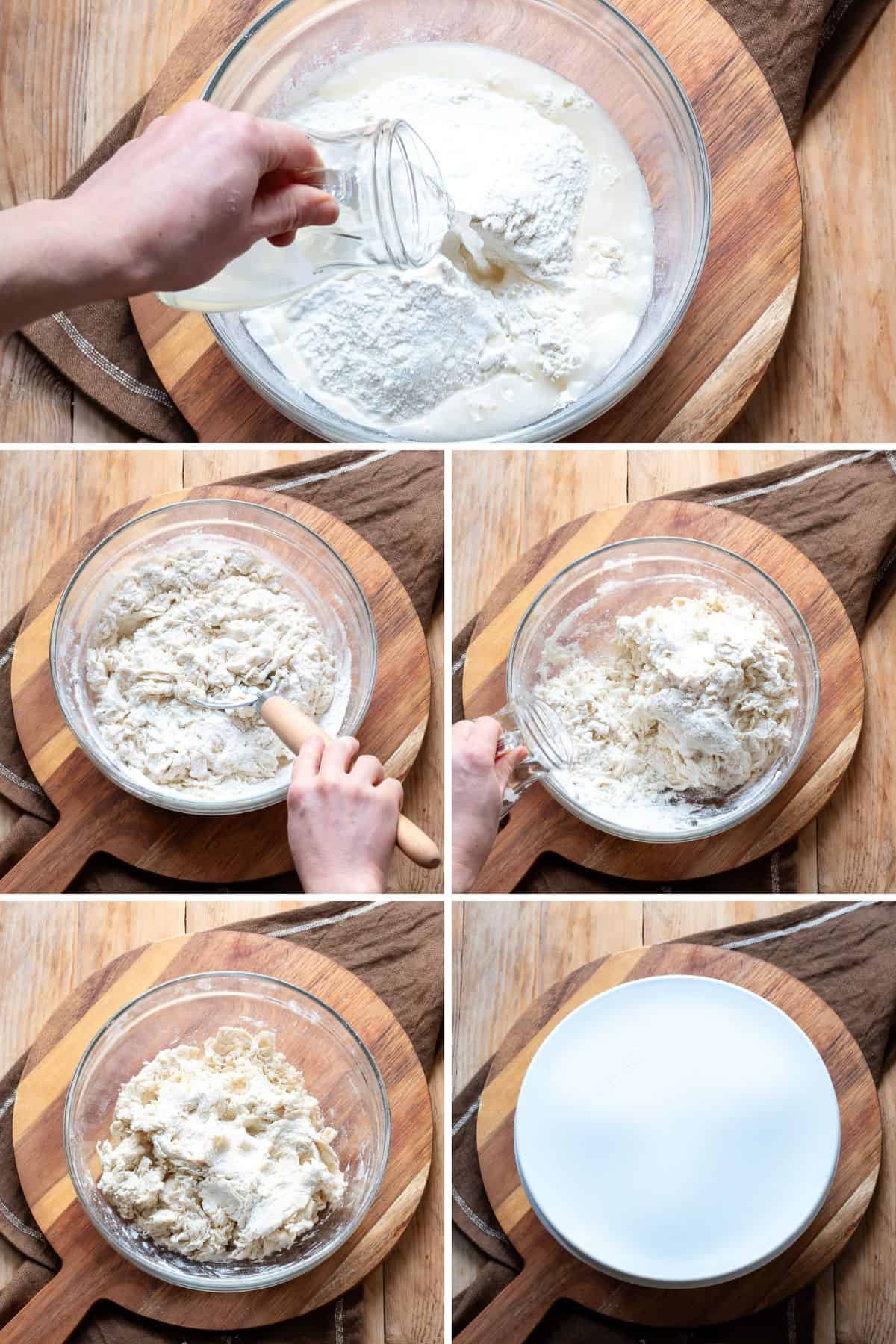
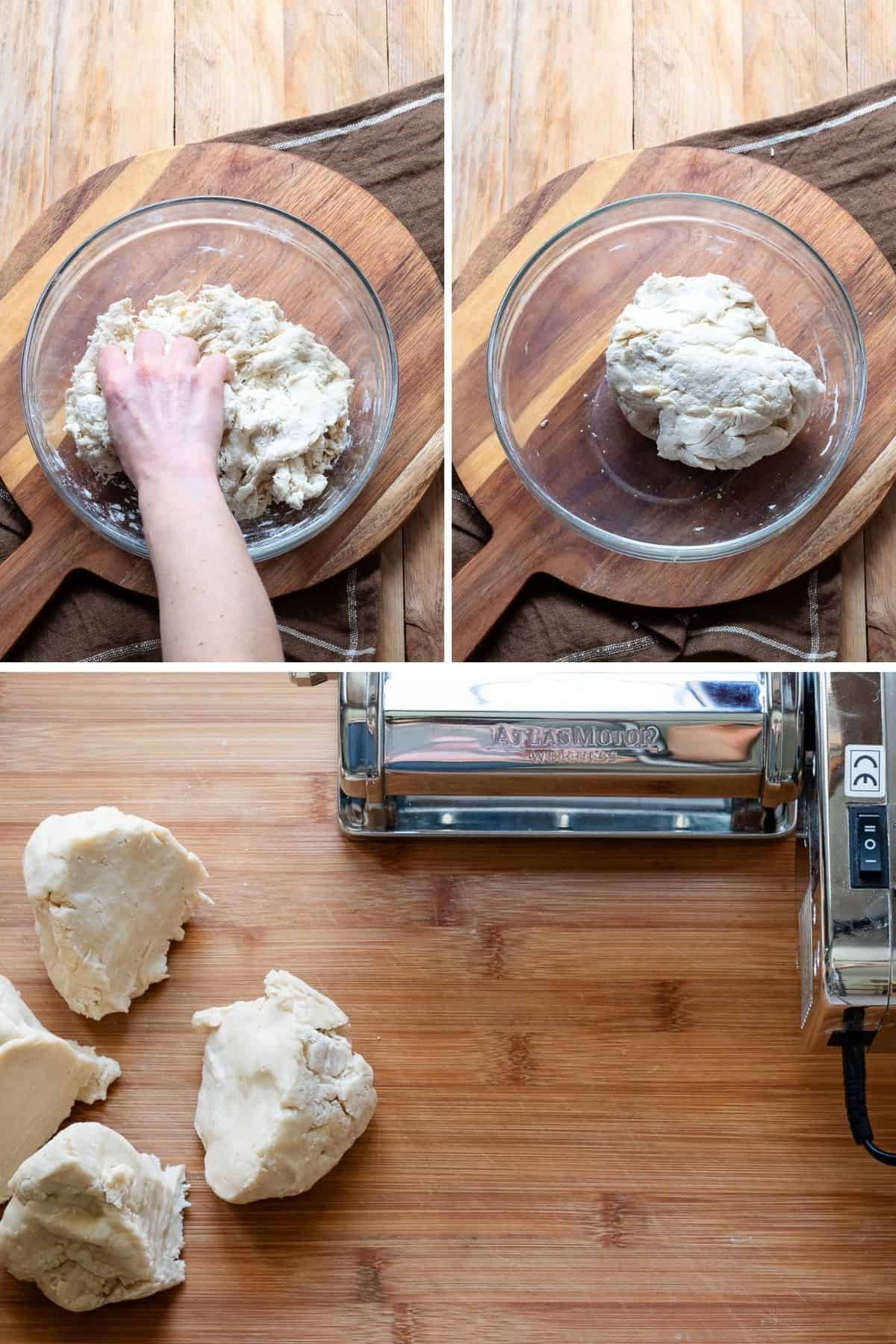
- Once the dough is rested, briefly knead it with your hands. Again, it won't be perfectly smooth.
- Divide the dough in 4 parts.
- Pass the first part of the dough through the pasta machine on its widest setting. On Marcato Altas it's setting “0 ”. Fold it over on itself, rotate and pass again on the same thickness setting until you get a sheet of dough without holes and relatively smooth. Adjust the knob to the next setting (1 on Marcato Atlas) and pass the dough.
- Set the regulating knob on the pasta machine to the next setting (setting 2) and pass the dough again. If needed pass the dough on the same setting several times repeating the folding process, until you get a smooth and even sheet.
- Continue adjusting the thickness setting and passing the dough until you get to the middle setting (setting 4-5 on Atlas Marcato).
- Wrap each dough sheets in plastic and let rest for 30 minutes.
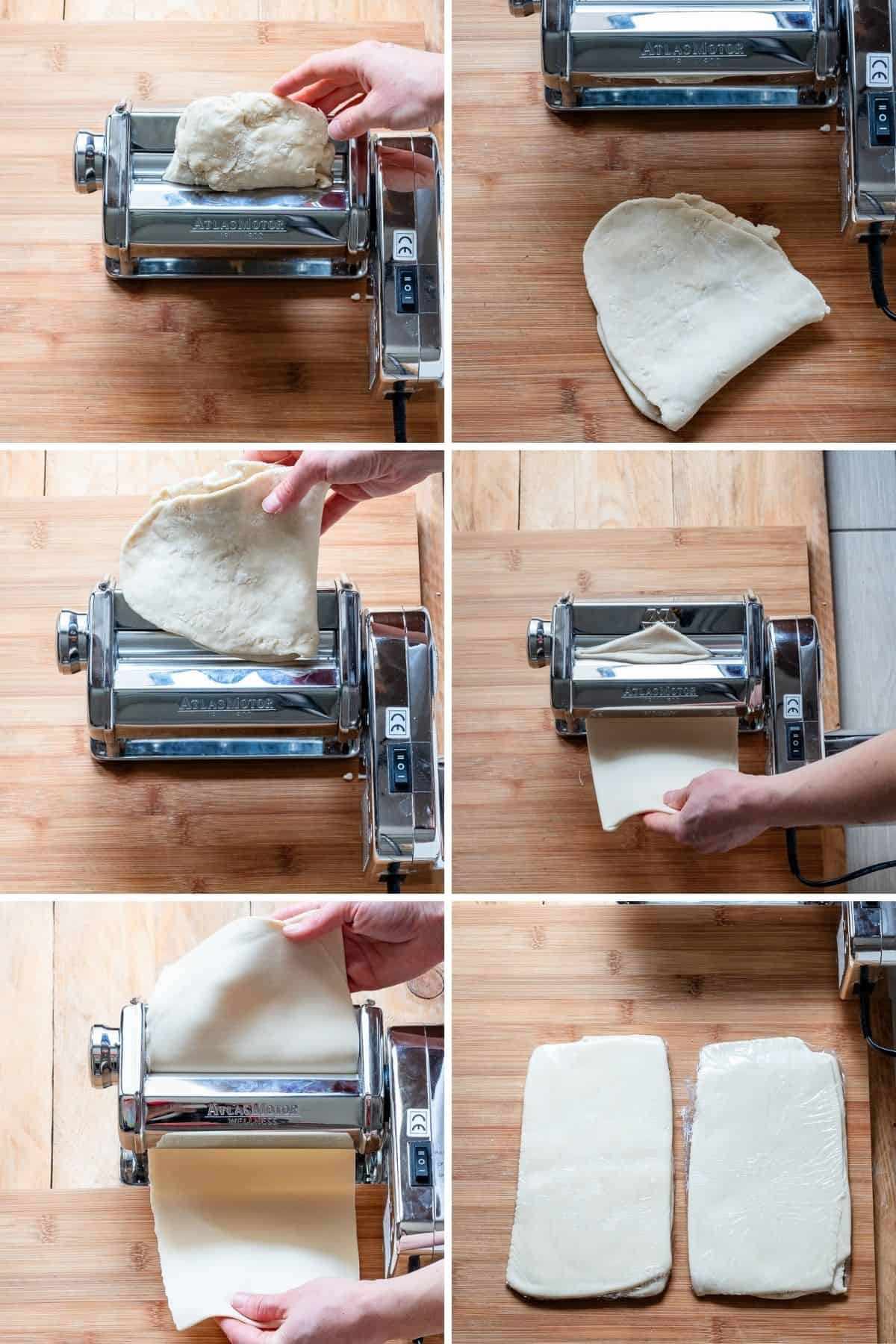
- Once the dough has rested, start working with one piece of the dough passing it through pasta maching until you get the thinnest sheet possible (setting 9 on Marcato Atlas Pasta Machine).
IMPORTANT: at no stage you should need to dust the dough with flour. If you make it correctly it won't stick to the pasta machine. If you have the dough that sticks a little bit you can lightly dust it with flour at while you're still working it on the widest setting of the pasta machine but never after that!
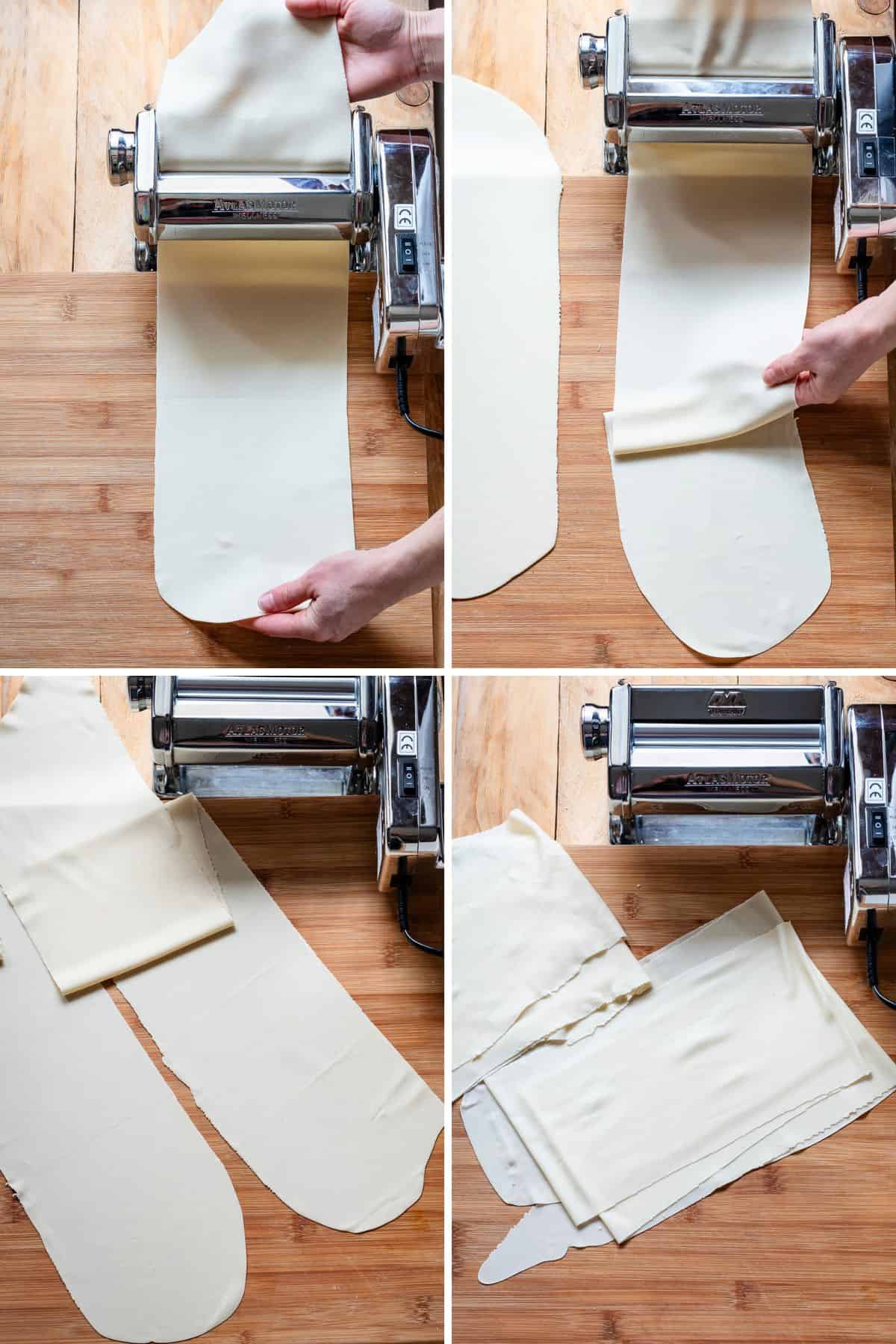
- Roll them dough sheets onto the rolling pin. The ends (handles) of the rolling pin should be settled between two water bottles or flour sacks to prevent the dough from touching the table.
- Repeat the same process with the remaining dough chunks.
TOP TIP: if it's your first time making this recipe, divide the dough between two rolling pins, this way the dough will be easier to unroll at the next step. - Cover the dough on the rolling pin with a plastic wrap and let rest 15 minutes.
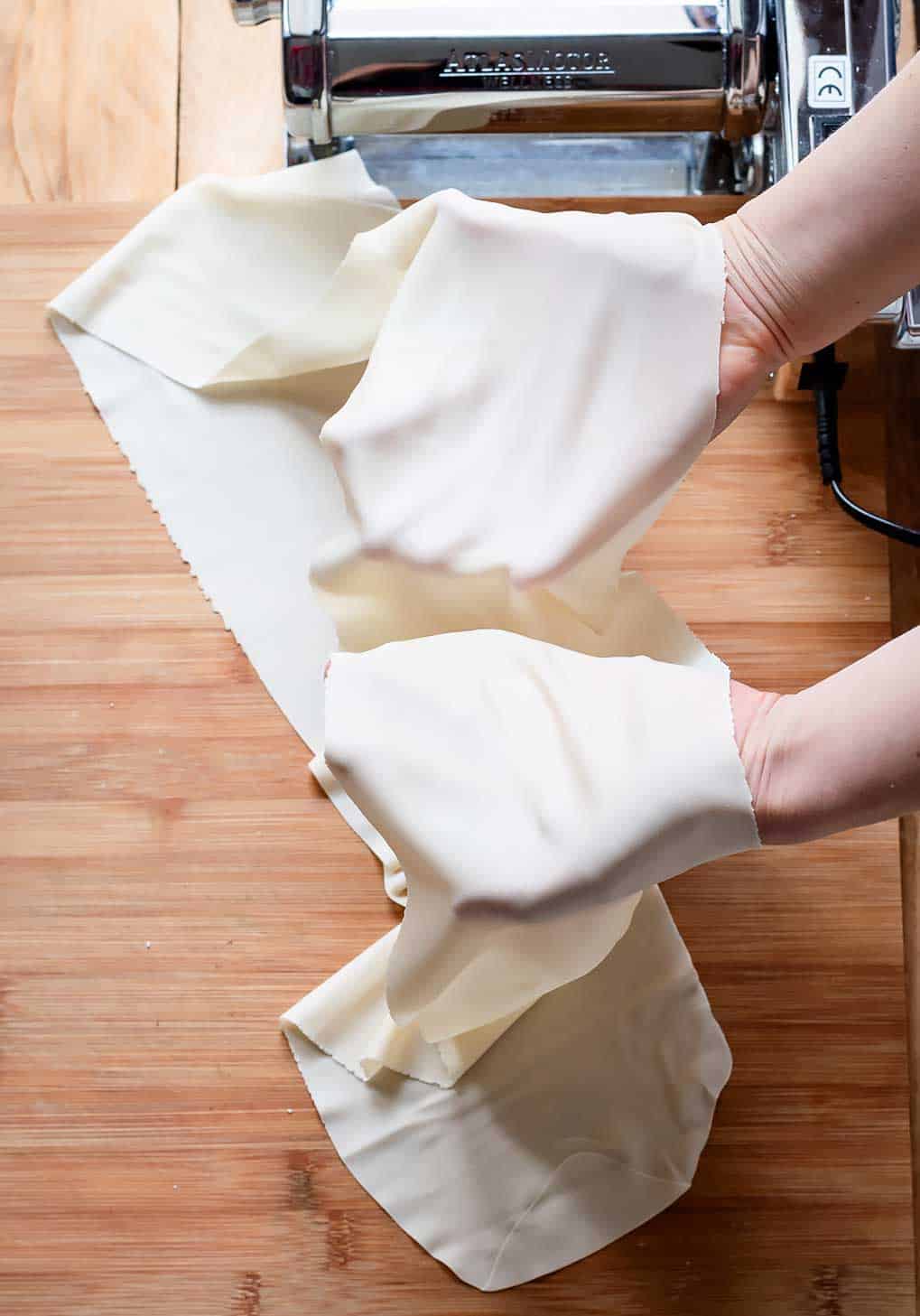
- Prepare lard at room temperature. If using butter, it should also be at room temperature (not melted!).
- Start to unfold the dough from the rolling pin. Stretch the dough to almost double its width and roll onto itself until you get a thin tight rope.
- Now thoroughly smear lard over the next section of the dough making sure to grease well the edges.
- Place your hands underneath the dough and gently stretch it outwards elongating it as much as possible without tearing. You should be able to almost double it in the widths.
- Roll the greased piece and unfold another section.
- Repeat the greasing, stretching and rolling process until you’ve used all the dough from the rolling pin.
- As a result you should get a kind of dough log. Grease it all over with lard/butter, cover with a plastic wrap and place in the fridge for at least 3 hours or better yet overnight.
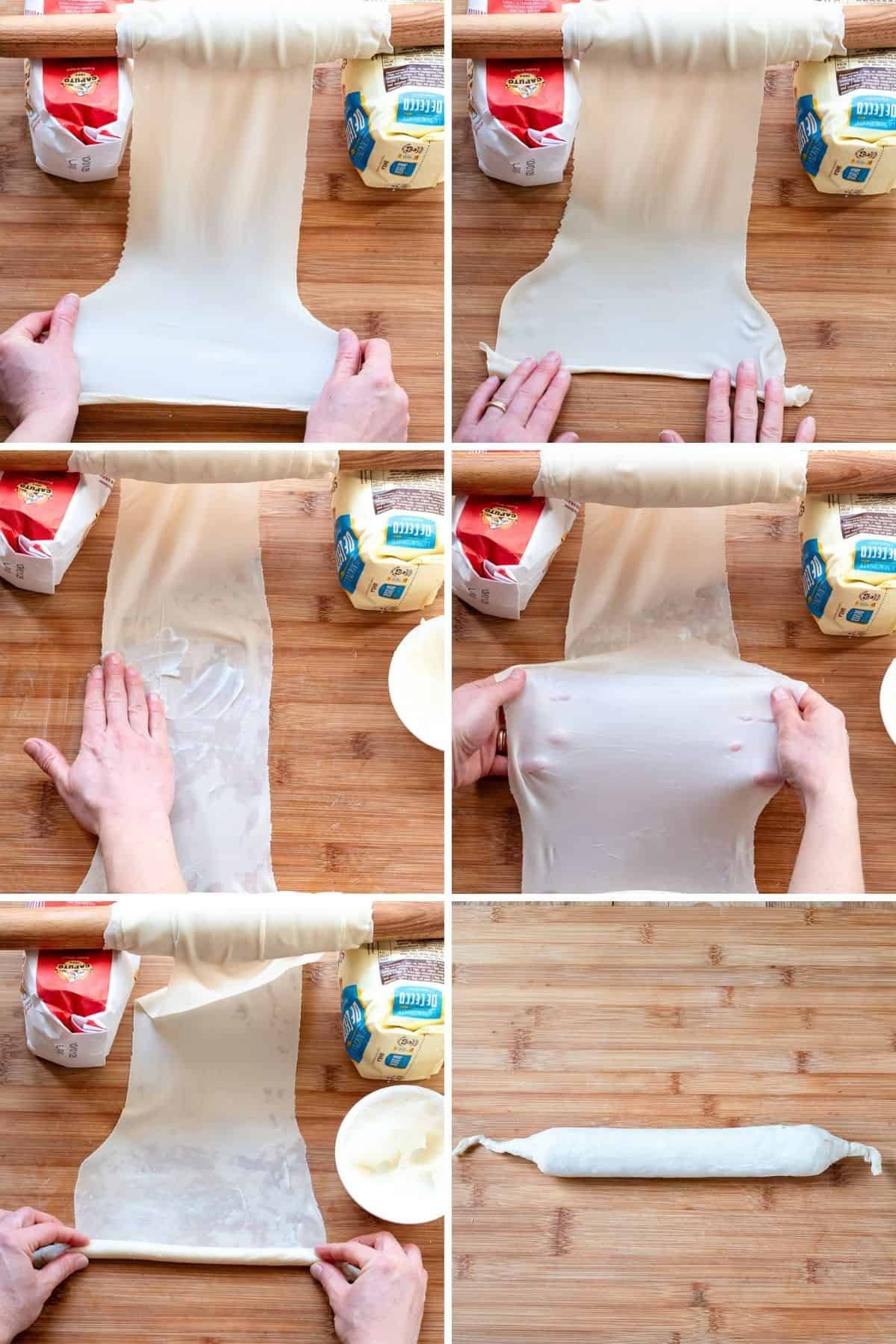
Prepare the cream
- In a stove-top pot add water, salt and sugar. Stir well and bring the mixture to boil.
- Constantly stirring slowly add semolina. Continue whisking to avoid formation of the lumps and cook for 3 minutes. Let cool completely. You can cook semolina the day before and let it rest covered at room temperature.
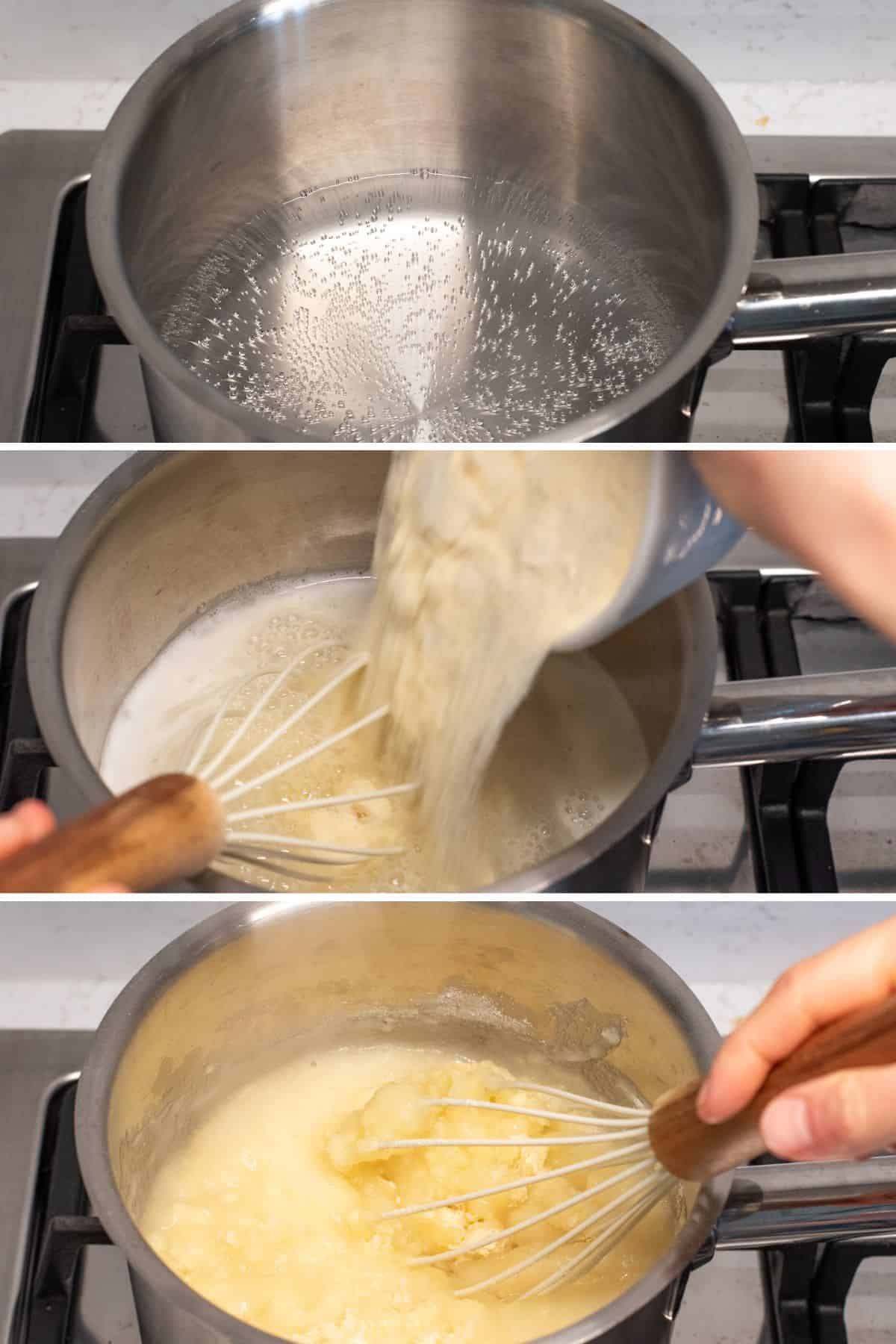
- In a large bowl add cooked semolina and beat with a mixer until creamy. Add ricotta, egg, cinnamon, vanilla and orange blossom water (or extract). Beat until you get smooth and even texture.
NOTE: if you don't have full ricotta this is the step where you add butter too. - Add candied oranges, mix and set aside or in the fridge until the next day.
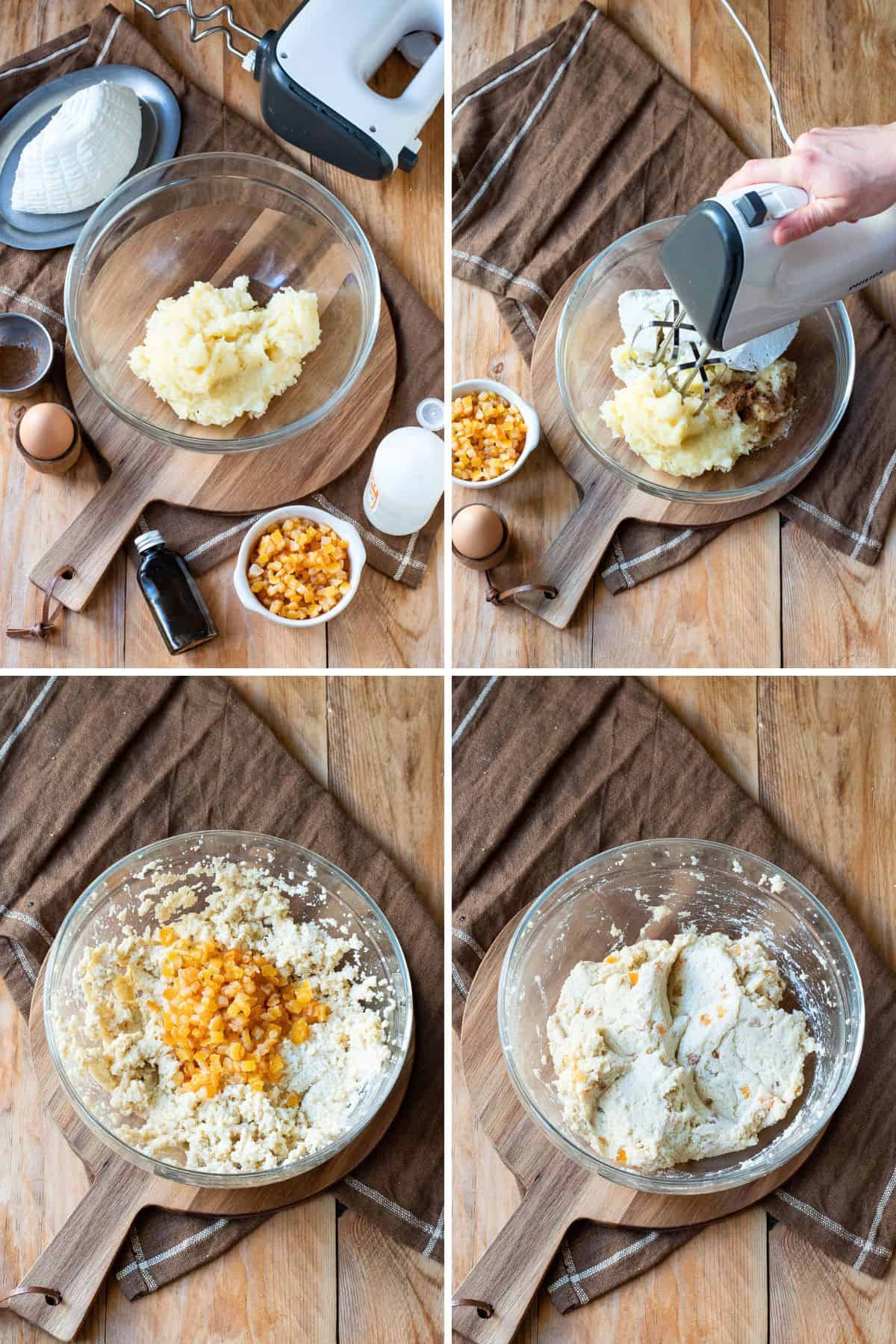
How To Shape Sfogliatelle
- Take the sfogliatelle dough log out of the fridge and while it’s still covered with a plastic wrap gently but firmly squeeze and stretch it with your hands going from the center towards the sides.
- Remove the plastic wrap and cut off the uneven side of the log, then cut into approx ¾ inch or 1.5-2cm slices.
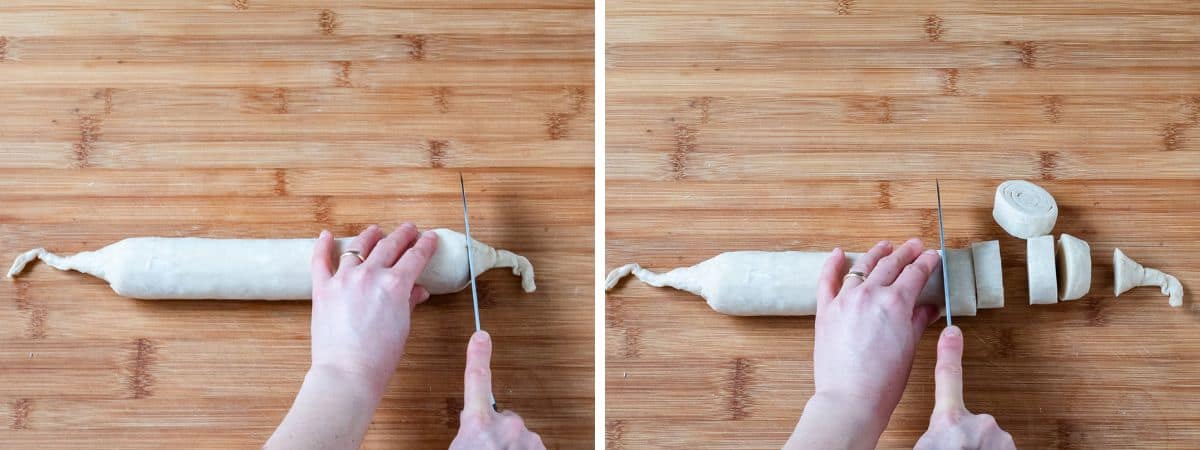
- To form the sfogliatelle cone, take a dough slice and start gently working it with your fingers. Using your thumbs and a rotating motion push the center of the slice out opening up dough layers and forming a cone shape.
Be careful not to push the layers too much apart, you still want them to stay together.
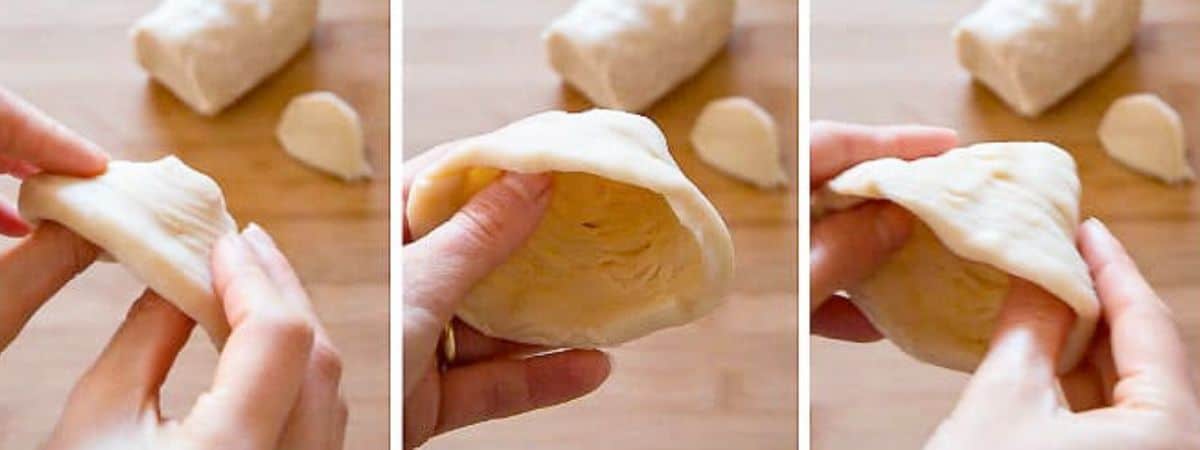
Stuff with filling and Bake
- Holding sfogliatella in one hand fill the cavity of the cone with ricotta cream.
IMPORTANT NOTE: Make sure to fill with enough cream so that sfogliatella stays full and puffy. If the cream is not enough it’ll simply flatten out in the oven. - Put together the edges of the opening as you can.
They don’t have to be perfectly sealed. The cream is thick enough to hold in the pastry.
Place sfogliatelle on a baking sheet lined with parchment paper.
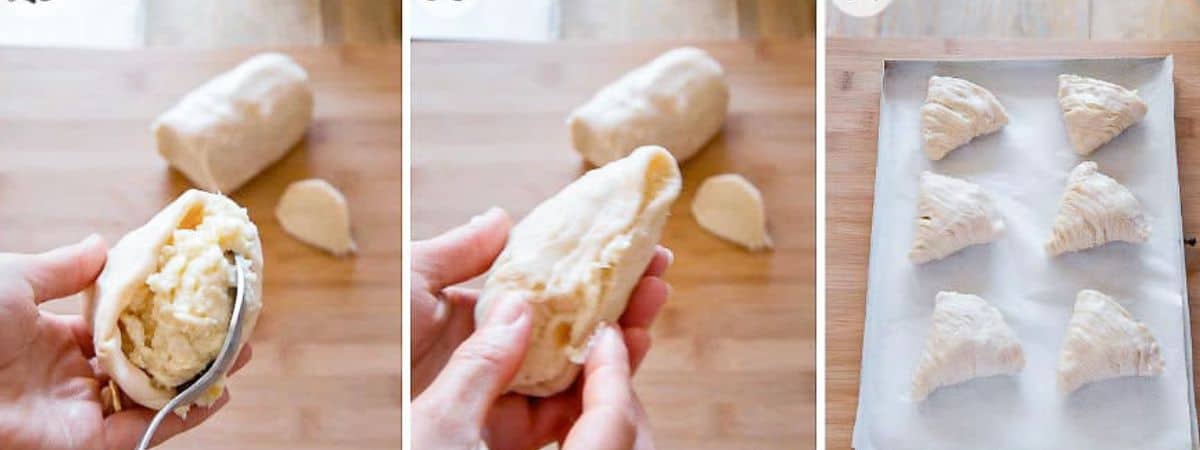
- Preheat the oven to 400F (200C).
Bake sfogliatelle in a preheated oven for 20-25 minutes until golden brown. - Serve warm generously dusted with powdered sugar.
If you have any leftover filling, you can freeze it or make these Lazy Sfogliatelle using just puff pastry and a knife!
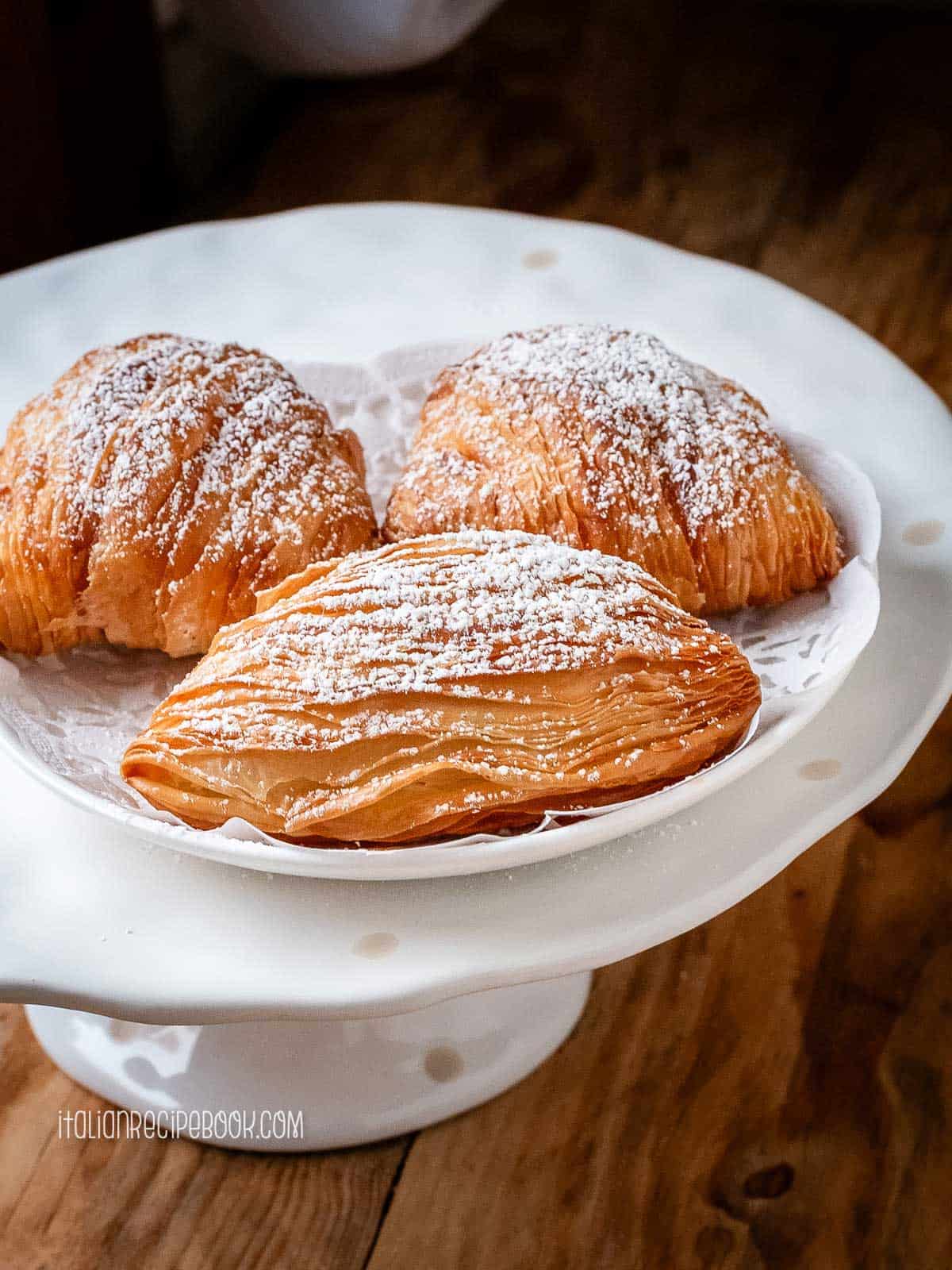
How To Store
The best way to store sfogliatelle is to freeze them uncooked right after stuffing. Bake them directly from frozen.
Cooked sfogliatelle will maintain their original crispiness for about 10-12 hours after making. If you can any leftovers, store them in a closed container in the fridge and reheat in the oven at 400F (200C) for 5-10 minutes before serving. This way they’ll get back their crispiness on the outside and warm delicious filling inside.
How To Freeze
Freeze sfogliatelle placed on a tray lined with parchment paper slightly distanced apart. Place in the freezer. Once they are frozen you can transfer them in a zip-lock plastic bag and pop back in the freezer.
Make Ahead
Can I make Sfogliatelle in advance? Absolutely! In fact, I strongly recommend you do so. You can make them weeks and even up to 3 months in advance. Store uncooked sfogliatelle in the freezer following the instructions above.
Alternatively you can prepare the dough up to 3 days in advance and the filling up to 2 days in advance and assemble everything the day you want to serve them.
FAQs
Sfogliatelle taste the best the day they’re made due to delicate cream filling and the layered crunchy pastry.
If not consumed the same day the moist filling will soften the crunchy shell. Sfogliatella will not go bad to say, but it will loose its characteristic crunchiness, but you can still reheat them the next day.
They should be consumed within 2 days.
Place frozen sofgliatelle on a baking sheet lined with parchment paper. Bake in a preheated to 400F (200C) oven for 25-30 minutes until nice golden brown.
Top Tips For Success
- Use kitchen scale to measure all ingredients in grams.
- Make sure to use high protein bread flour.
- Resist adding extra water. Sfogliatelle dough SHOULD be crumbly after first kneading.
- Don't skip resting time. The dough should rest 4 times: after first kneading, after rolling through pasta machine, a quick rest before greasing and lastly once greased with lard (at least 3 hours in the fridge or even better overnight). Skipping any of the resting time will compromise the dough structure and make it difficult to work with.
- Use lard. You can get high quality lard easily at the grocery store or online. While it's technically possible to use butter, the result will be a far cry from the original. There's the reason why authentic Neapolitan Sfogliatelle recipe calls for lard!
- If possible make sfogliatelle dough and sfogliatelle cream filling the day before. You'll have a better dough and more energy to finish making them the next day. This way the next day all you have to do it shape, fill sfogliatelle with cream and bake.
Small Batch - Mini Sfogliatelle

These mini sfogliatelle are perfect if you want to give this pastry a try. They're much easier to handle and quicker to make. Once you've mastered mini sfogliatelle you can make classic ones with confidence.
Having said that, in our family we prefer mini sfogliatelle to the classic ones. They're are a perfect size end of the meal treat and disappear in 2 bites!
Mini Sfogliatelle dough:
- bread flour - 150 grams
- water - 60 grams
- honey - 1 tsp
- salt - ½ tsp
The process of making mini sfogliatelle is exactly the same.
Small batch ricotta cream filling is not worth the effort, so I highly recommend making a full batch and if needed freeze the leftovers.
This Sfogliatelle recipe was originally published on February 25th, 2018. It has been updated with more helpful information and new photos.
Full Recipe
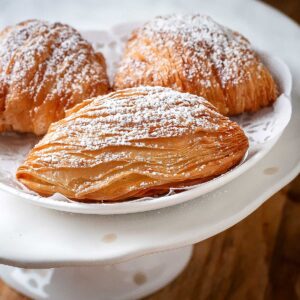
Sfogliatelle Ricce - Authentic Recipe Step By Step
Ingredients
Sfogliatelle Dough:
- 500 grams bread flour
- 190 grams water
- 1 teaspoon salt
- 1 tablespoon honey
- 150 grams cooking lard (best) or butter (170 grams)
Sfogliatelle Cream:
- 450 grams full fat ricotta cheese , 1 lb
- 2 cups water
- ¾ cup semolina flour semola (140 grams)
- ½ cup sugar (110 grams)
- ¼ cup candied orange peel
- 1 egg
- ½ teaspoon ground cinnamon
- 1 tablespoon vanilla extract
- 1 tablespoon orange blossom water
- ¼ teaspoon salt
- 60 grams butter , 2 ounces (optional, see notes)
Instructions
Preparing the dough
- Dissolve honey and salt in water. In a large bowl, add flour and water mix saving a few tablespoons for later. Mix with a fork or a Danish dough whisk until crumbly. Separate dough lumps from the dry flour left at the bottom.Add the remaining water to the dry flour and mix with your hands letting the dough absorb any remaining dry flour. The dough will be super lumpy and that's how it should be! It’ll all come together later in the process.Cover the dough and let sit for 30 minutes.Using a stand mixer? Follow the same process.500 grams bread flour, 190 grams water, 1 tablespoon honey, 1 teaspoon salt
- Once the dough is rested, briefly knead it with your hands. Again, it won't be perfectly smooth.Divide the dough in 4 parts.Pass the first part of the dough through the pasta machine on its widest setting. On Marcato Altas it's setting “0 ”. Fold it over on itself, rotate and pass again on the same thickness setting until you get a sheet of dough without holes and relatively smooth. Adjust the knob to the next setting (1 on Marcato Atlas) and pass the dough.Set the regulating knob on the pasta machine to the next setting (setting 2) and pass the dough again. If needed pass the dough on the same setting several times repeating the folding process, until you get a smooth and even sheet.Continue adjusting the thickness setting and passing the dough until you get to the middle setting (setting 4-5 on Atlas Marcato).Wrap each dough sheets in plastic and let rest for 30 minutes. Once the dough has rested, start working with one piece of the dough passing it through pasta machine until you get the thinnest sheet possible (setting 9 on Marcato Atlas Pasta Machine).IMPORTANT: at no stage you should need to dust the dough with flour. If you make it correctly it won't stick to the pasta machine. If you have the dough that sticks a little bit you can lightly dust it with flour at while you're still working it on the widest setting of the pasta machine but never after that!
- Roll them dough sheets onto the rolling pin. The ends (handles) of the rolling pin should be settled between two water bottles or flour sacks to prevent the dough from touching the table.Repeat the same process with the remaining dough chunks.TOP TIP: if it's your first time making this recipe, divide the dough between two rolling pins, this way the dough will be easier to unroll at the next step.Cover the dough on the rolling pin with a plastic wrap and let rest 15 minutes.
- Prepare lard at room temperature. If using butter, it should also be at room temperature (not melted!).Start to unfold the dough from the rolling pin. Stretch the dough to almost double its width and roll onto itself until you get a thin tight rope.Now thoroughly smear lard over the next section of the dough making sure to grease well the edges.Place your hands underneath the dough and gently stretch it outwards elongating it as much as possible without tearing. You should be able to almost double it in the width.Roll the greased piece and unfold another section.Repeat the greasing, stretching and rolling process until you’ve used all the dough from the rolling pin.As a result you should get a kind of dough log. Grease it all over with lard/butter, cover with a plastic wrap and place in the fridge for at least 3 hours or better yet overnight.
- In the meantime prepare the cream.
Preparing the cream:
- In a stove-top pot add water, salt and sugar. Stir well and bring the mixture to a boil.2 cups water, ½ cup sugar, ¼ teaspoon salt, 60 grams butter
- Constantly stirring slowly add semolina. Continue whisking to avoid the formation of the lumps and cook for 3 minutes. Let cool completely. You can cook semolina the day before and let it rest covered at room temperature.¾ cup semolina flour
- In a large bowl add cooked semolina and beat with a mixer until creamy. Add ricotta, egg, cinnamon, vanilla and orange blossom water (or extract). Beat until you get smooth and even texture.NOTE: if you don't have full ricotta this is the step where you add butter too.Add candied oranges, mix and set aside or in the fridge until the next day.¼ cup candied orange peel, ½ teaspoon ground cinnamon, 1 tablespoon vanilla extract, 1 tablespoon orange blossom water
Shaping & Baking Sfogliatelle
- Take the sfogliatelle dough log out of the fridge and while it’s still covered with a plastic wrap gently but firmly squeeze and stretch it with your hands going from the center towards the sides.Remove the plastic wrap and cut off uneven sides of the log, then cut into approx ¾ inch (1.5-2 cm) thick slices.
- To form the sfogliatelle cone, take a dough slice and start gently working it with your fingers.Using your thumbs and a rotating motion push the center of the slice out opening up dough layers and forming a cone shape. Be careful not to push the layers too much apart, you still want them to stay together.
- Holding sfogliatella in one hand fill the cavity of the cone with ricotta cream. Make sure to fill with enough cream so that sfogliatelle stay full and puffy. If the cream is not enough they’ll simply flatten out in the oven.Put together the edges of the opening as you can, they don’t have to be perfectly sealed. The cream is thick enough to hold in the pastry.Place sfogliatelle on a baking sheet lined with parchment paper.
- Preheat the oven to 400F (200C).Bake sfogliatelle in a preheated oven for 20-25 minutes until golden brown.
- Serve warm generously dusted with confectioners’ sugar.
Notes
Nutrition
Nutrition information is automatically calculated, so should only be used as an approximation.
Sfogliatelle Ricce vs Sfogliatelle Frolle
Neapolitan sfogliatelle nowadays are found of two kinds: riccia (meaning “curly”) and frolla (from the Italian name for shortbread, “pasta frolla”, where “frolla” literally means “fazed”). They differ both in form and texture.
Sfogliatella riccia is more similar to the original one, assuming the one made by nuns in Conca dei marmi actually was a sort of puff pastry. Riccia’s fan shape is obtained by forming a pocket from a reel of extremely thinly rolled dough whose centre is pushed out with fingers. That’s why sfogliatella unrolls like streamers when you eat it.
Sfogliatella frolla, as the name suggests, is made of shortbread and can also come in oval or round shape.
The dough is soft and not crunchy at all. It melts in the mouth because the filling keeps it slightly moist, especially a few hours after baking. The taste of the crust is similar to a slightly sweet shortbread crust.
Deciding which is the best is somehow like deciding if you love mum or dad the most. The crunchiness of sfogliatella riccia paired with velvety citrusy ricotta filling is unforgettable. It’s this contrast that makes sfogliatella riccia an experience rather than just a dessert.
On the other hand, sfogliatella frolla is so reassuring, allowing you to give a larger bite without crumbling too much, and to fill your mouth with a soft triumph of sweetened ricotta cheese and delicate orange scent.
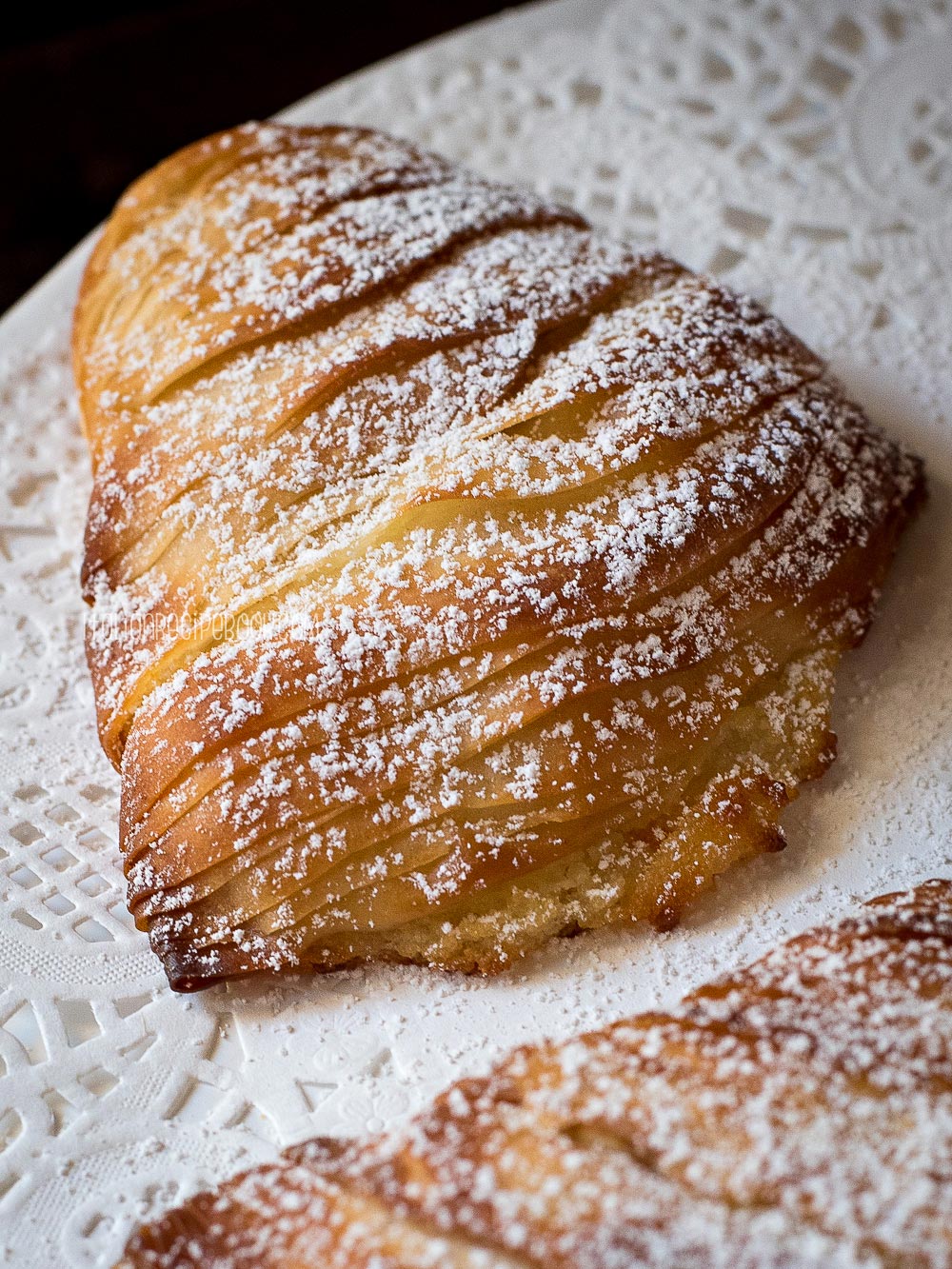
How Sfogliatella Was Born - Story
According to the story, which is surprisingly univocal for an Italian dish, sfogliatelle were invented by a nun in the Santa Rosa monastery on the Amalfi riviera, back in the XVI century.
She noticed some left semolina, that had already been cooked in milk, so she decided to flavor it with other ingredients and to make some sort of cake, not to throw away something that could not be preserved.
She added dried fruit - a common ingredient to add sweetness at the times refined sugar was not available - and a lemon-scented liqueur that we are allowed to assume was similar to nowadays limoncello.
She then wrapped it all in puff pastry and baked it.
The story tells the sfogliatella, whose shape at first meant to resemble a monk’s hood, was offered to peasants of the village of Conca dei Marmi, where the monastery of Santa Rosa da Lima is still found, as a compensation for the foods they used to bring to the nuns.
Soon sfogliatelle became a beloved pastry and precious trade goods.
It is not clear how he did it exactly, but the story goes on by saying that in the XIX century a certain Pasquale Pintauro from Naples acquired the receipt, jealously kept secret by the monastery until then.
At that time, Pintauro was actually an innkeeper, but nowadays he is remembered as a pastry chef and his name is definitely linked to sfogliatella.
He converted his tavern into a pastry shop and started selling sfogliatelle, with some slight amendments to the recipe.
It’s allegedly Pasquale Pintauro the one to whom we now owe the two main kinds of sfogliatelle: riccia e frolla.
Buon Appetito!




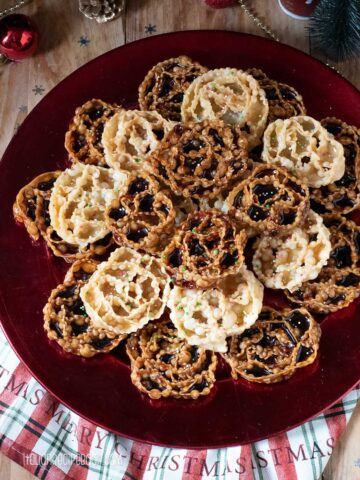
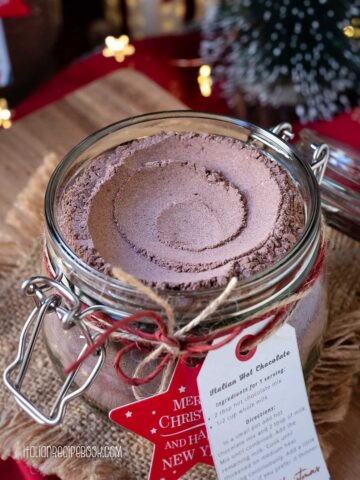
Alessia
do you have any tips on stretching? found that this time around (it’s been a year since the first time i made these) the pastry tore a fair bit !
Svitlana
Hi Alessia, to prevent pasta from tearing here's what I would do:
1. Make sure you use high protein bread flour (at least 12.5%) - for example I find that Italian pizza flour works wonders in this recipe.
2. Let the dough rest covered after every next 2 or 3 settings on the pasta machine. For example, you start passing pasta through the pasta machine for the final round (your dough rectangles are smooth) on setting 1, 2 then 3. Cover with cling film and let rest for 10 minutes. Pass each rectangle again, this time setting 4, 5 and 6. As the dough gets longer you might want to divide it into smaller rectangles so they fit the table surface without folding onto itself. Cover again with plastic and let rest for 10 minutes. Now you'll be able to roll to the thinnest setting.
3. Divide the dough between 2 or even 3 rolling pins if you have an opportunity. This way it will be easier to unroll the dough, stretch and grease at the final stage.
Try these 3 tips, they should help you get the perfectly thin dough.
Happy to answer any other questions you might have.
John Marconi
Is there a video for making sfogliatelle
Annisa
If I want to make half the recipe, can I just use the egg yolk or I need to half the whole egg? Does the egg whites makes a different? Because usually custard only use egg yolk
Italian Recipe Book
Yes, if you half the Sfogliatelle recipe use egg yolk only.
Alternatively you can make the amount indicated in the recipe and freeze any leftover cream, it keeps really well.
Emma
Hi, no matter what I do, my dough always sticks together, mostly when it is on the rolling pin. I have the right flour, I do all the steps correctly, and still... I have tried sfogliatelle with several recipes, always the same. It is frustrating. And I'm no novice to baking!
Ines
Here is what I have done that works. Work with a section at a time. I roll out the section, gently stretch out the dough as shown in the instructions, apply the Crisco, start to roll tightly. Leave about an inch of the dough unrolled.Set the cylinder aside and roll out another section of the dough. Connect the end of the second greased section to the end of the previous section that you have already rolled. Continue to do this until all dough used. This way you can avoid the sticking problem that you have had. Good luck! This pastry is really worth the effort.
Diana
These were great! Definitely labor intensive but they taste just like the ones I got in Naples. One question… I have a lot of filling left. Can I freeze it?
Amelia
Hello, thank you for your beautiful recipe instructions. Would you be able to tell me about how many Sfogliatelle can be made using this full recipe? Approximately, how many small size From s recipe and how many of the larger size from this recipe? Would you say that the ones that you are showing in your photos are the large size? How many of those size were you able to produce with this full recipe, please? Regarding size I’m thinking about what you typically see in the bakery as a small size and as the large size. Thank you again for all of your beautiful Italian recipes. I’m so happy to have found your site!
Eva
So much work in writing that post! Congratulations
Italian Recipe Book
Thank you Eva Sfogliatelle recipe requires some work and I feel that giving the most extensive step by step process is essential for success.
Irene
Tried your recipe. The instructions were easy to follow. Had a problem with the dough being sticky. When I put it on the rolling pin was so sticky I had a hard time getting it off. Any suggestions.
Cathie
Your recipe sounds amazing and easy to follow. Do you have a recipe for the Sfogliatelle Frolle? My family loves them and i would love to try and make some! Thank you
Italian Recipe Book
Hi Cathie, I don't the recipe for Sfogliatelle frolle , YET, but you gave me a good idea! Apologies for my slow reply. I will definitely let you know once the new recipe is published.
Theresa
Very challenging, time-consuming but absolutely WORTH IT! Your step by step photos were really helpful. Grazie!
Missy
I had HORRIBLE LUCK WITH THIS! Directions are missing alot of IMPORTANT information! Like to stretch the dough so thin it almost tears, to use ALOT of shortening in between layers they were a pia to form cones and they were hard as rock! Found another recipe with pate choux like another reviewer said worked beautiful. This could be good if I used all the info in a different recipe. Also your photo does not match the finished product in your video!!
Italian Recipe Book
Hi Missy, you must be leaving this review on the wrong website.
I don't have (and never had) a video of sfogliatelle recipe, so my final photos and my step by step (super thorough) instructions pictures are what you really get when you make them.
Lisa Orlando
Hi, As an Italian American kid in the 50s, I ate a lot of sfogliatelle, but I don’t eat sugar anymore, so, while in Italy, I learned to stand in front of pastry counters and say, “Salate?” Imagine my shock, across the street from Napoli Centrale, when I was handed a sfoliatella with a tiny piece of salami on top. And it was delicious! But, searching on line for “sfogliatelle salate ,” all I find is in Italian, and my Italian is very poor. Do you have any recipes for these? Or even any history? Thank you.
Tina Boydston
My sister and I took on the challenge of making this recipe after obsessing about the Sfogliatelle we had in Naples in May. I'm happy to say it was a successful project. I wish I could attach a photo. But I'll post one on Instagram under tinalorab. We followed the recipe. The only change we made was to roll each section as it came out of the pasta roller. So we did not roll it onto the rolling pin then unroll it. We were amazed at how easy the dough was to work with. Coming out of the pasta roller it was beautifully thin and pliable. We rested it for about 3 hours. It was hard to roll it out any further as described in the recipe. After it was cut, we tried baking a few at a time until we got the hang of really stretching the layers as we formed the cone for the filling. The first couple were too thick. You really have to work at separating the layers as you form the cone without leaving holes. It really wasn't hard once we got the hang of it. We tried a couple of different temps for the oven. Started at 380, bumped it to 425 and then settled on convection 375. We did sprinkle a little sugar on each after the first couple of tries and found this really helped them brown evenly. They came our amazing and the filled was so good. They were both crunchy and chewy. I'm very happy with the effort. One thing I did learn though, In Naples the vendors can't be making these themselves. They're all so perfect and taste the same. They have to be machine made, frozen and baked off. This was a great experiment in making a complex pastry. Thank for the detailed recipe.
Bea
I just found your site and I just love it!!! I'm so excited to try your recipes and especially this one...my mouth is watering thinking about it. Looking forward to future recipes
Italian Recipe Book
Thank you so much for taking your time and dropping me a comment ❤
Hope you enjoy Sfogliatelle and visit IRB for more
Mely
Wonderful recipe! Do you drain the liquid from the ricotta before you use it?
Italian Recipe Book
Thank you Mely! Glad you enjoyed my sfogliatelle
It's a good idea to drain excess liquid from ricotta but if there's just a tiny bit it won't make a difference, so feel free to use it as is.
Ogi the Yogi
Hi! Thank you so much for the detailed recipe! I absolutely cannot justify spending so much money on the Semolina Rimacinata, would it be possible to use the Semolina Bob's Red Mill, it's the coarse kind. Thank you!
Italian Recipe Book
Hi Ogi! Thanks for stopping by and glad you appreciated the detailed instructions. You can totally use semolina brand you have. I've recently run out of semolina and used semola instead and it worked great as well!
Let me know if you have any other questions and of course how your sfogliatelle will come out 🙂
Natalie
This is such an amazing pastry! I had it when I visited Italy a few years ago and its simply divine - no less! Looks incredible and I have to try this recipe soon!
Italian Recipe Book
Ahah, this is how it works with sfogliatelle - if you've tried it once you'll never forget its taste. Thanks so much for commenting Natalie ❤️ Would love to hear from you when you make them!